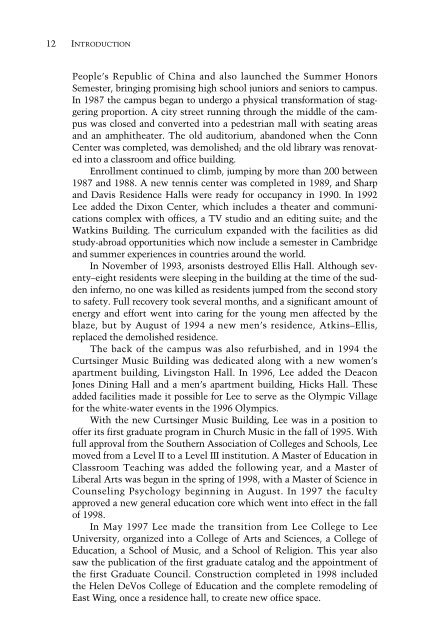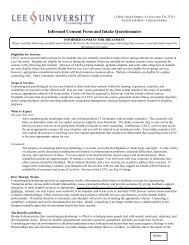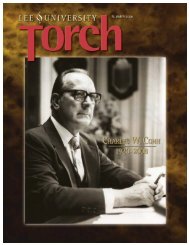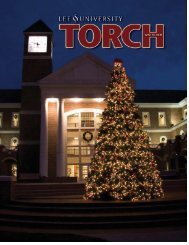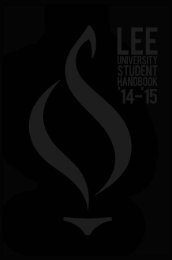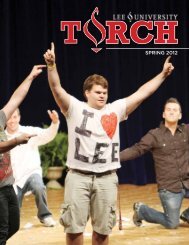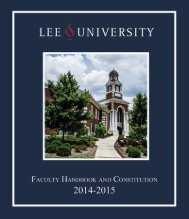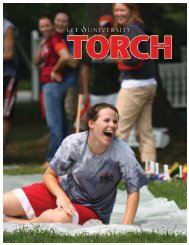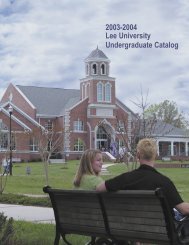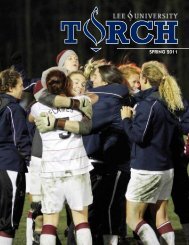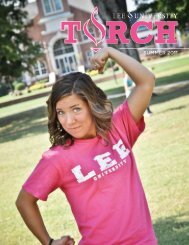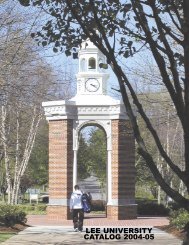- Page 4 and 5: CONTENTS INTRODUCTION Accreditation
- Page 6 and 7: 6 INTRODUCTION INTRODUCTION ACCREDI
- Page 8 and 9: 8 INTRODUCTION the knowledge, appre
- Page 10 and 11: 10 INTRODUCTION In the Lord’s Sup
- Page 16 and 17: 16 ADMISSIONS Admissions If you wan
- Page 18 and 19: 18 ADMISSIONS may submit scores on
- Page 20 and 21: 20 ADMISSIONS taking the Math Place
- Page 24 and 25: 24 ACADEMIC PROGRAMS Academic Progr
- Page 26 and 27: 26 ACADEMIC PROGRAMS B.S. Chemistry
- Page 28 and 29: 28 ACADEMIC PROGRAMS GENERAL CURRIC
- Page 30 and 31: 30 ACADEMIC PROGRAMS Students enrol
- Page 32 and 33: 32 ACADEMIC PROGRAMS Electives Subj
- Page 34 and 35: 34 ACADEMIC PROGRAMS available for
- Page 36 and 37: 36 ACADEMIC PROGRAMS Required or Pe
- Page 38 and 39: 38 ACADEMIC PROGRAMS Grades Grades
- Page 40 and 41: 40 ACADEMIC PROGRAMS C. All indepen
- Page 42 and 43: 42 ACADEMIC PROGRAMS 3. The admissi
- Page 44 and 45: 44 ACADEMIC PROGRAMS SPECIAL ACADEM
- Page 46 and 47: 46 ACADEMIC PROGRAMS earn up to six
- Page 48: 48 ACADEMIC PROGRAMS Colleges and U
- Page 51 and 52: FINANCIAL INFORMATION 51 Single stu
- Page 53 and 54: FINANCIAL INFORMATION 53 Fall Semes
- Page 55 and 56: FINANCIAL INFORMATION 55 FINANCIAL
- Page 57 and 58: FINANCIAL INFORMATION 57 responsibi
- Page 59 and 60: FINANCIAL INFORMATION 59 United Sta
- Page 61 and 62: FINANCIAL INFORMATION 61 LEE UNIVER
- Page 63 and 64:
FINANCIAL INFORMATION 63 Hicks Scho
- Page 65 and 66:
FINANCIAL INFORMATION 65 Archie L.
- Page 67 and 68:
FINANCIAL INFORMATION 67 Karen Hank
- Page 69 and 70:
FINANCIAL INFORMATION 69 University
- Page 71 and 72:
FINANCIAL INFORMATION 71 P. Marley
- Page 73 and 74:
FINANCIAL INFORMATION 73 an annual
- Page 75 and 76:
FINANCIAL INFORMATION 75 shall be e
- Page 77 and 78:
FINANCIAL INFORMATION 77 includes f
- Page 80 and 81:
80 STUDENT ACTIVITIES & SERVICES CA
- Page 82 and 83:
82 STUDENT ACTIVITIES & SERVICES sp
- Page 84 and 85:
84 STUDENT ACTIVITIES & SERVICES So
- Page 86 and 87:
86 STUDENT ACTIVITIES & SERVICES CO
- Page 88 and 89:
88 STUDENT ACTIVITIES & SERVICES Wh
- Page 91 and 92:
▼ ▼ ▼ ▼ ▼ UNIVERSITY PROG
- Page 93 and 94:
COLLEGE OF ARTS AND SCIENCES 93 PRE
- Page 95 and 96:
DEPARTMENT OF BEHAVIORAL AND SOCIAL
- Page 97 and 98:
DEPARTMENT OF BEHAVIORAL AND SOCIAL
- Page 99 and 100:
DEPARTMENT OF BEHAVIORAL AND SOCIAL
- Page 101 and 102:
DEPARTMENT OF BEHAVIORAL AND SOCIAL
- Page 103 and 104:
DEPARTMENT OF BEHAVIORAL AND SOCIAL
- Page 105 and 106:
DEPARTMENT OF BEHAVIORAL AND SOCIAL
- Page 107 and 108:
DEPARTMENT OF BEHAVIORAL AND SOCIAL
- Page 109 and 110:
DEPARTMENT OF BEHAVIORAL AND SOCIAL
- Page 111 and 112:
DEPARTMENT OF BEHAVIORAL AND SOCIAL
- Page 113 and 114:
DEPARTMENT OF BEHAVIORAL AND SOCIAL
- Page 115:
DEPARTMENT OF BEHAVIORAL AND SOCIAL
- Page 118 and 119:
118 COLLEGE OF ARTS AND SCIENCES Th
- Page 120 and 121:
120 COLLEGE OF ARTS AND SCIENCES BA
- Page 122 and 123:
122 COLLEGE OF ARTS AND SCIENCES BA
- Page 124 and 125:
124 COLLEGE OF ARTS AND SCIENCES BA
- Page 126 and 127:
126 COLLEGE OF ARTS AND SCIENCES CI
- Page 128 and 129:
128 COLLEGE OF ARTS AND SCIENCES CI
- Page 130 and 131:
130 COLLEGE OF ARTS AND SCIENCES BU
- Page 132 and 133:
132 COLLEGE OF ARTS AND SCIENCES AC
- Page 134 and 135:
134 COLLEGE OF ARTS AND SCIENCES BU
- Page 136 and 137:
136 COLLEGE OF ARTS AND SCIENCES CI
- Page 139 and 140:
DEPARTMENT OF COMMUNICATION AND THE
- Page 141 and 142:
DEPARTMENT OF COMMUNICATION AND THE
- Page 143 and 144:
DEPARTMENT OF COMMUNICATION AND THE
- Page 145 and 146:
DEPARTMENT OF COMMUNICATION AND THE
- Page 147 and 148:
DEPARTMENT OF COMMUNICATION AND THE
- Page 149 and 150:
DEPARTMENT OF COMMUNICATION AND THE
- Page 151 and 152:
DEPARTMENT OF COMMUNICATION AND THE
- Page 153 and 154:
DEPARTMENT OF ENGLISH AND MODERN FO
- Page 155 and 156:
DEPARTMENT OF ENGLISH AND MODERN FO
- Page 157 and 158:
DEPARTMENT OF ENGLISH AND MODERN FO
- Page 159 and 160:
DEPARTMENT OF ENGLISH AND MODERN FO
- Page 161 and 162:
DEPARTMENT OF ENGLISH AND MODERN FO
- Page 163 and 164:
DEPARTMENT OF ENGLISH AND MODERN FO
- Page 165 and 166:
DEPARTMENT OF ENGLISH AND MODERN FO
- Page 167 and 168:
DEPARTMENT OF ENGLISH AND MODERN FO
- Page 169 and 170:
DEPARTMENT OF ENGLISH AND MODERN FO
- Page 171:
DEPARTMENT OF ENGLISH AND MODERN FO
- Page 174 and 175:
174 COLLEGE OF ARTS AND SCIENCES Th
- Page 176 and 177:
176 COLLEGE OF ARTS AND SCIENCES BA
- Page 178 and 179:
178 COLLEGE OF ARTS AND SCIENCES BA
- Page 180 and 181:
180 COLLEGE OF ARTS AND SCIENCES BA
- Page 182 and 183:
182 COLLEGE OF ARTS AND SCIENCES BA
- Page 184 and 185:
184 COLLEGE OF ARTS AND SCIENCES EL
- Page 186 and 187:
186 COLLEGE OF ARTS AND SCIENCES BA
- Page 188 and 189:
188 COLLEGE OF ARTS AND SCIENCES MI
- Page 190 and 191:
190 COLLEGE OF ARTS AND SCIENCES BI
- Page 192 and 193:
192 COLLEGE OF ARTS AND SCIENCES BI
- Page 194 and 195:
194 COLLEGE OF ARTS AND SCIENCES a
- Page 196 and 197:
196 COLLEGE OF ARTS AND SCIENCES HS
- Page 198 and 199:
198 COLLEGE OF ARTS AND SCIENCES co
- Page 200 and 201:
200 COLLEGE OF ARTS AND SCIENCES MA
- Page 202 and 203:
202 HELEN DEVOS COLLEGE OF EDUCATIO
- Page 204 and 205:
204 HELEN DEVOS COLLEGE OF EDUCATIO
- Page 206 and 207:
206 HELEN DEVOS COLLEGE OF EDUCATIO
- Page 208 and 209:
208 HELEN DEVOS COLLEGE OF EDUCATIO
- Page 210 and 211:
210 HELEN DEVOS COLLEGE OF EDUCATIO
- Page 212 and 213:
212 HELEN DEVOS COLLEGE OF EDUCATIO
- Page 214 and 215:
214 HELEN DEVOS COLLEGE OF EDUCATIO
- Page 216 and 217:
216 HELEN DEVOS COLLEGE OF EDUCATIO
- Page 218 and 219:
218 HELEN DEVOS COLLEGE OF EDUCATIO
- Page 220 and 221:
220 HELEN DEVOS COLLEGE OF EDUCATIO
- Page 222 and 223:
222 HELEN DEVOS COLLEGE OF EDUCATIO
- Page 224 and 225:
224 HELEN DEVOS COLLEGE OF EDUCATIO
- Page 226 and 227:
226 HELEN DEVOS COLLEGE OF EDUCATIO
- Page 228 and 229:
228 HELEN DEVOS COLLEGE OF EDUCATIO
- Page 230 and 231:
230 SCHOOL OF MUSIC SCHOOL OF MUSIC
- Page 232 and 233:
232 SCHOOL OF MUSIC BACHELOR OF ART
- Page 234 and 235:
234 SCHOOL OF MUSIC Subtotal Profes
- Page 236 and 237:
236 SCHOOL OF MUSIC MISCELLANEOUS M
- Page 238 and 239:
238 SCHOOL OF MUSIC AP - Advanced P
- Page 240 and 241:
240 SCHOOL OF MUSIC MUS 416. IMPROV
- Page 242 and 243:
242 SCHOOL OF MUSIC MUS 391. VOCAL
- Page 244 and 245:
244 SCHOOL OF MUSIC MUS 242. SIGHTS
- Page 246 and 247:
246 SCHOOL OF RELIGION DEPARTMENT O
- Page 248 and 249:
248 SCHOOL OF RELIGION YOUTH MINIST
- Page 250 and 251:
250 SCHOOL OF RELIGION BACHELOR OF
- Page 252 and 253:
252 SCHOOL OF RELIGION BACHELOR OF
- Page 254 and 255:
254 SCHOOL OF RELIGION BACHELOR OF
- Page 256 and 257:
256 SCHOOL OF RELIGION GENERAL EDUC
- Page 258 and 259:
258 SCHOOL OF RELIGION COLLATERAL R
- Page 260 and 261:
260 SCHOOL OF RELIGION The student
- Page 262 and 263:
262 SCHOOL OF RELIGION BIB 305. THE
- Page 264 and 265:
264 SCHOOL OF RELIGION CED 341. PRI
- Page 266 and 267:
266 SCHOOL OF RELIGION ISP 354. THE
- Page 268 and 269:
268 SCHOOL OF RELIGION 15-20 page p
- Page 270 and 271:
270 SCHOOL OF RELIGION Youth Minist
- Page 272 and 273:
272 SCHOOL OF RELIGION Examinations
- Page 276 and 277:
276 ALUMNI ASSOCIATION LEE UNIVERSI
- Page 278 and 279:
278 ALUMNI ASSOCIATION In 1994, a n
- Page 282 and 283:
282 ADMINISTRATION, FACULTY & STAFF
- Page 284 and 285:
284 ADMINISTRATION, FACULTY & STAFF
- Page 286 and 287:
286 ADMINISTRATION, FACULTY & STAFF
- Page 288 and 289:
288 ADMINISTRATION, FACULTY & STAFF
- Page 290 and 291:
290 ADMINISTRATION, FACULTY & STAFF
- Page 292 and 293:
292 ADMINISTRATION, FACULTY & STAFF
- Page 294 and 295:
294 ADMINISTRATION, FACULTY & STAFF
- Page 296 and 297:
296 ADMINISTRATION, FACULTY & STAFF
- Page 298 and 299:
298 ADMINISTRATION, FACULTY & STAFF
- Page 300 and 301:
300 ADMINISTRATION, FACULTY & STAFF
- Page 302 and 303:
302 ADMINISTRATION, FACULTY & STAFF
- Page 304 and 305:
304 ADMINISTRATION, FACULTY & STAFF
- Page 306 and 307:
306 UNIVERSITY CALENDAR SCHOOL CALE
- Page 308 and 309:
308 UNIVERSITY CALENDAR January (co
- Page 310 and 311:
310 UNIVERSITY TELEPHONE DIRECTORY
- Page 312 and 313:
312 UNIVERSITY TELEPHONE DIRECTORY
- Page 314 and 315:
314 INDEX Changing a Schedule......
- Page 316 and 317:
316 INDEX Parking .................
- Page 318 and 319:
318 KEY CONTACTS KEY CONTACTS - QUI


